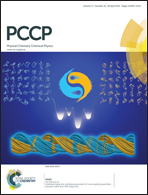Organic nanoparticles of malachite green with enhanced far-red emission: size-dependence of particle rigidity†
Abstract
In tracing the biological processes using fluorescent probes, it is desirable to shift the excitation/emission energy to a far-red/near-infrared (FR/NIR) region. In this study, we successfully synthesize FR fluorescent organic nanoparticles via ion-association between the malachite green (MG) cations and tetrakis(4-fluorophenyl)borate (TFPB) anions in the presence of a neutral stabilizing polymer. Binding of MG with TFPB results in the prominent appearance of an absorption band that can be assigned to an H-aggregate of MG. The fluorescence intensity as well as the fluorescence lifetime shows a significant increase with a decrease in the nanoparticle size. Since the MG dye is known as a local viscosity or environmental rigidity probe showing a rotational friction dependence of the excited state lifetime, we find that the rigidity of the organic nanoparticle is strongly size-dependent; that is, the smaller the size of the nanoparticle, the greater the rigidity of the nanoparticle. We also reveal that surface regions of the ion-based organic nanoparticles are more rigid than inner regions. The presence of H-aggregates that are almost non-fluorescent is the major origin of aggregation-caused quenching (ACQ) and still avoids the enhancement of the fluorescence quantum yield of the MG nanoparticles, so we develop a new approach to prevent H-aggregation inside the nanoparticle by incorporating photochemically inert, bulky phosphonium cations, which results in a 430-fold enhancement of its fluorescence yield. We believe that such a methodology will open up an avenue in the development of new types of fluorescent nanomaterials for many applications.


 Please wait while we load your content...
Please wait while we load your content...